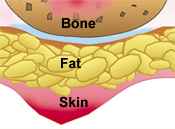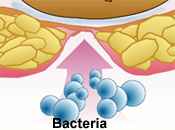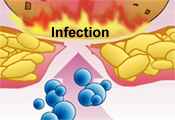Whether you're going long for that touchdown pass or standing in line at the bank, you depend on your feet to keep you moving. Diabetes increases your chances of developing foot problems. If you are a diabetic, you cannot afford to take your feet for granted. Give them the special care they need.
Diabetics' feet have fewer defenses against everyday wear and tear. Nerve damage
is common. This can lead to injuries that go unnoticed. Reduced blood flow can prevent
injuries from healing and lead to serious infections. The point is that diabetics need to pay special attention
to their feet. The following gives suggestions on how to inspect your feet, what to look for,
and ways to prevent serious foot damage.
|
|
| Nerves let you feel pain, vibration, pressure, heat, and cold | Damaged Nerves may make it difficult for you to feel pain, pressure, heat and cold. |
| Blood Vessels Carry nutrients and oxygen to your feet to nourish them and help them heal from injuries. | Blocked Blood Vessels bring fewer nutrients and oxygen to your feet. Without nourishment, sores may not be able to heal. |
| Bones give your foot shape and help distribute the pressure from your body's weight. | Weakened Bones may slowly shift, causing your foot to become deformed and changing the way your foot distributes pressure. |
| Joints are the connections between your bones. They help absorb pressure and allow your foot to move. Your arch is a group of joints that provides stability for you entire foot | Collapsed Joints, especially a collapsed arch, can no longer absorb pressure or provide stability. The surrounding skin may begin to break down. |
 |
 |
 |
| Medical History Your doctor and other health care team members need to know about any foot problems you have had in the past. You may also be asked about medications you're taking. Your answers help your doctor determine the level of care your feet need. |
Possible Tests Your health care team may request these or other tests to help pinpoint your particular problems.
|
| Foot Examination A foot exam can reveal circulation, nerve, skin, bone, or joint problems. By taking each font's pulse, your doctor can check how well blood circulates. Your doctor examines the condition of your skin and looks for any weakness of collapse in your bones and joints. The sensitivity of your skin may also be checked. |
Your Treatment PlanYour health care provider uses the results of your evaluation to create an individual foot care program for you. Your program may range from developing an effective self-care routine to treating minor foot problems to surgery. |
Preventing foot infections is the best step toward protecting the health of your feet. Your Health Care Provider examines your feet regularly, teaches you about self-care, provides foot "maintainance" and may recommend special footwear to help extra relieve pressure.
| Examining Your Feet Regularly Even if you don't have symptoms now, they could develop quickly. Follow your schedule for regular exams. Give your health care provider the opportunity to monitor the blood flow and feeling in your feet, as well as to catch small foot injuries before they develop into larger infections. |
Providing Routine Foot Care Routine foot care helps keep thick and ingrown nails, blisters, corns, calluses, and other skin irritations from developing into ulcers or infections. Your health care team may:
|
| Teaching You Self-Care The more you know about diabetes and your feet, the better you can monitor your foot health. A member of your health team can teach you warning signs and how to inspect your feet, as well as many other foot care tips. But make sure to ask any questions you have about your foot health. |
Providing Customized Foot ware If areas of your feet have been damaged by extra pressure, you may be referred to a podiatrist for customized footwear. It protects pressure-sensitive areas of your feet and helps keep existing skin irritations from worsening. |
Inspecting your feet helps you catch small irritations before they become serious infections. Check daily for these warning signs that could mean your feet are in trouble. If you cannot see your feet, ask a relative or friend to help. And see your doctor right away if you find a problem.
|
|
| |
| Safe To Do | Dangerous | |
| For Cold Feet | Wear warm socks or wrap your feet in a blanket | Do not warm your feet with a heater, heating pad, or hot water bottle |
| To Clean Feet | Clean your feet in a shower or bath tub | Do not use foot soaks |
| Sitting | Sit with both feet on the floor | Do not cross your legs when you sit |
| Wearing Socks | Wear socks that fit smoothly and are not tight | Do not wear garters or tight socks |
| Buying Shoes | Wear walking shoes that fit well and are comfortable | Do not wear shoes that are too tight or uncomfortable. Never go barefoot. |
| Home | Diet | Food Chart | Exercise | Gestational | Glossary | Injections | Insulin | Hypoglycemia |